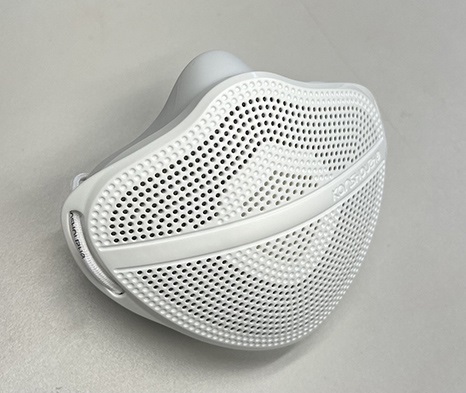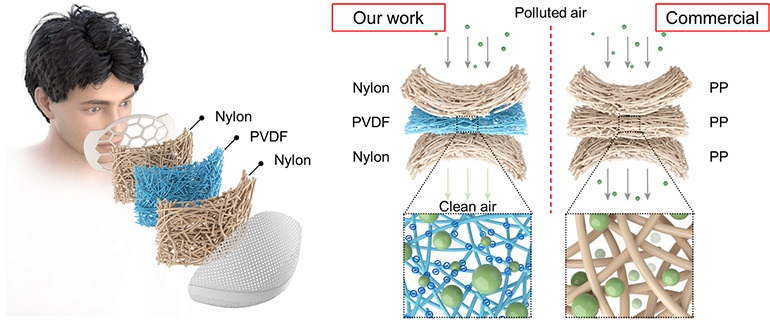Medical Innovation: Hong Kong Researchers Develop Electrostatic Face Mask That Self-Charges During Breathing!
Medical Innovations - Electrostatic Face Mask That Self-Charges Mar 08, 2023 2 years, 1 month, 2 weeks, 4 days, 10 hours, 51 minutes ago
Medical Innovations: The worlds’s first electrostatically charged face mask that can replenish its charge through the wearer’s breathing action has been developed by researchers from the City University of Hong Kong have developed an electrostatically charged face mask that can replenish its charge through the wearer’s breathing action. This significantly increase the filtering performance in prolonged use of the mask for up to 60 hours, compared to four hours for a conventional surgical mask.

According to the researchers, electrostatic adsorption is an important complement to the mechanical filtration for high-efficiency air filtering. However, the electrostatic charge decays with time, especially in humid conditions. In this work, a self-charging air filter is presented to capture airborne particles in an efficient and long-lasting manner without the need of external power sources. Leveraging the triboelectric effect between the electrospun poly (vinylidene fluoride) nanofiber film and nylon fabric, the self-charging air filter-based mask excited by breathing can continuously replenish electrostatic charges. As a result, its effective lifespan is up to 60 hours (including 30 hours of wearing), with a minimum filtration efficiency of 95.8% for 0.3-μm particles. The filtration efficiency and lifespan are significantly higher than those of a commercial surgical mask. Furthermore, we uncover the quantitative relation between filtration efficiency and surface electrostatic potential. This work provides an effective strategy to significantly prolong the electrostatic adsorption efficacy for high-performance air-filtering masks.
The researchers published an article detailing the development and test of one of their new
Medical Innovations involving the world’s first electrostatically charged face mask that recharges via the wearer’s breathing action in the peer reviewed journal: nature Communications.
https://www.nature.com/articles/s41467-022-35521-w
The electrostatic charge helps the mask to adsorb tiny particles and inhibit viruses including the SARS-CoV-2 viruses.
One key issue is that such masks typically lose their charge and ability to bind particles over time, particularly in humid environments such as right in front of the mouth.
In order to circumvent this, these researchers created a mask with two triboelectric nylon fabric layers that replenish the charge as the layers move back and forth during breathing.
These masks can provide protection against airborne viruses for much longer than conventional masks, enhancing the safety of healthcare staff and reducing waste.
The face mask has been a key component in our fight against COVID-19. For most of us, face masks were a mild inconvenience when we went to the store, mid-pandemic, in an effort to reduce viral transmission in the community. However, for healthcare staff caring for COVID-19 patients, effective masks are crucial for both personal and patient safety.
A proven effective mechanism that designers can deploy in face masks invol
ves electrostatic adsorption, where an electrostatic charge helps tiny particles to stick within the masks, helping to complement the mechanical filtration that the masks provide. However, this electrostatic charge is depleted over time, particularly in humid conditions, which are difficult to avoid in something you breathe through.
Hence this means that the masks may not be providing optimal protection for their entire duration of wear and also that masks must be exchanged frequently, creating waste.
 Self-charging air-filtering mask with prolonged electrostatic adsorption. (a) Schematic diagram of the proposed self-charging air-filtering mask. (b) Enhanced particle capture capacity with the PVDF/nylon pair (left) employed in the SAF compared with the PP/PP (or PP/PE) pair (right) in a surgical mask. The close-up illustrations indicate the efficient electrostatic adsorption for fine particles with the SAF design. Credit: © Dr Yang Zhengbao’s Group / City University of Hong Kong
Self-charging air-filtering mask with prolonged electrostatic adsorption. (a) Schematic diagram of the proposed self-charging air-filtering mask. (b) Enhanced particle capture capacity with the PVDF/nylon pair (left) employed in the SAF compared with the PP/PP (or PP/PE) pair (right) in a surgical mask. The close-up illustrations indicate the efficient electrostatic adsorption for fine particles with the SAF design. Credit: © Dr Yang Zhengbao’s Group / City University of Hong Kong
This innovative facemask technology maintains its protection against viral particles by generating electric charge from the movement of the breath.
Dr Yang Zhengbao, a researcher and co-developer of the face mask told Thailand Medical News, “Though many reports work on replenishing the charge for long-lasting electrostatic adsorption efficacy, an extra power source is generally needed, which is cumbersome and inconvenient. We have developed an efficient, durable, low-cost air filter that can continuously replenish the electrostatic charge in a self-charging manner.”
This new innovative technology relies on triboelectric nylon fabric layers that can create an electric charge when moved.
Dr Zhengbao explained, “As the middle layer moves forth and back between the lateral layers with breathing, a charge transfer occurs between PVDF and nylon due to their large difference in electron affinity, resulting in the PVDF layer being negatively charged and the nylon layers positively charged. This self-charging process enables the continuous replenishment of the electrostatic charges and prolonged electrostatic adsorption.”
Leveraging the triboelectric effect between the electrospun poly(vinylidene fluoride) nanofiber film and nylon fabric, the self-charging air filter-based mask excited by breathing can continuously replenish electrostatic charges. As a result, its effective lifespan is up to 60 hours (including 30 hours of wearing), with a minimum filtration efficiency of 95.8% for 0.3-μm particles. The filtration efficiency and lifespan are significantly higher than those of a commercial surgical mask.
Furthermore, the researchers uncovered the quantitative relation between filtration efficiency and surface electrostatic potential. This work provides an effective strategy to significantly prolong the electrostatic adsorption efficacy for high-performance air-filtering masks.
Typically, most face masks have three functional layers: a core melt-blown polypropylene (PP) layer as the filter medium and two spun-bonding nonwoven fabrics (generally PP or polyethylene (PE)) as the supporting layers, including a hydrophilic layer, worn inwards, to absorb moisture from breathing and a hydrophobic layer, worn outwards, to repel fluid.
Electrospinning provides better mechanical filtration than the melt-blown technology extensively used in the industry. But mechanical filtration alone does not provide enough protection. One solution is to introduce an electric field to give the filter medium an electrostatic charge, which facilitates ultrafine particle trapping.
The raw material cost of SAF for making one mask is as low as HK$0.47, making it the most cost-effective option among the commonly used masks, such as surgical, N95, KF94 and KN95 masks.
The researchers also established a quantitative relationship between filtration efficiency and surface electrostatic potential, which is important for standardized, high-efficiency industrial production.
The mask is already in commercial production and is expected to be launched in coming weeks, probably in time before the H5N1 Avian Flu or H3N2 Flu global pandemics are announced!
For the latest on
Medical Innovations, keep on logging to Thailand Medical News.

